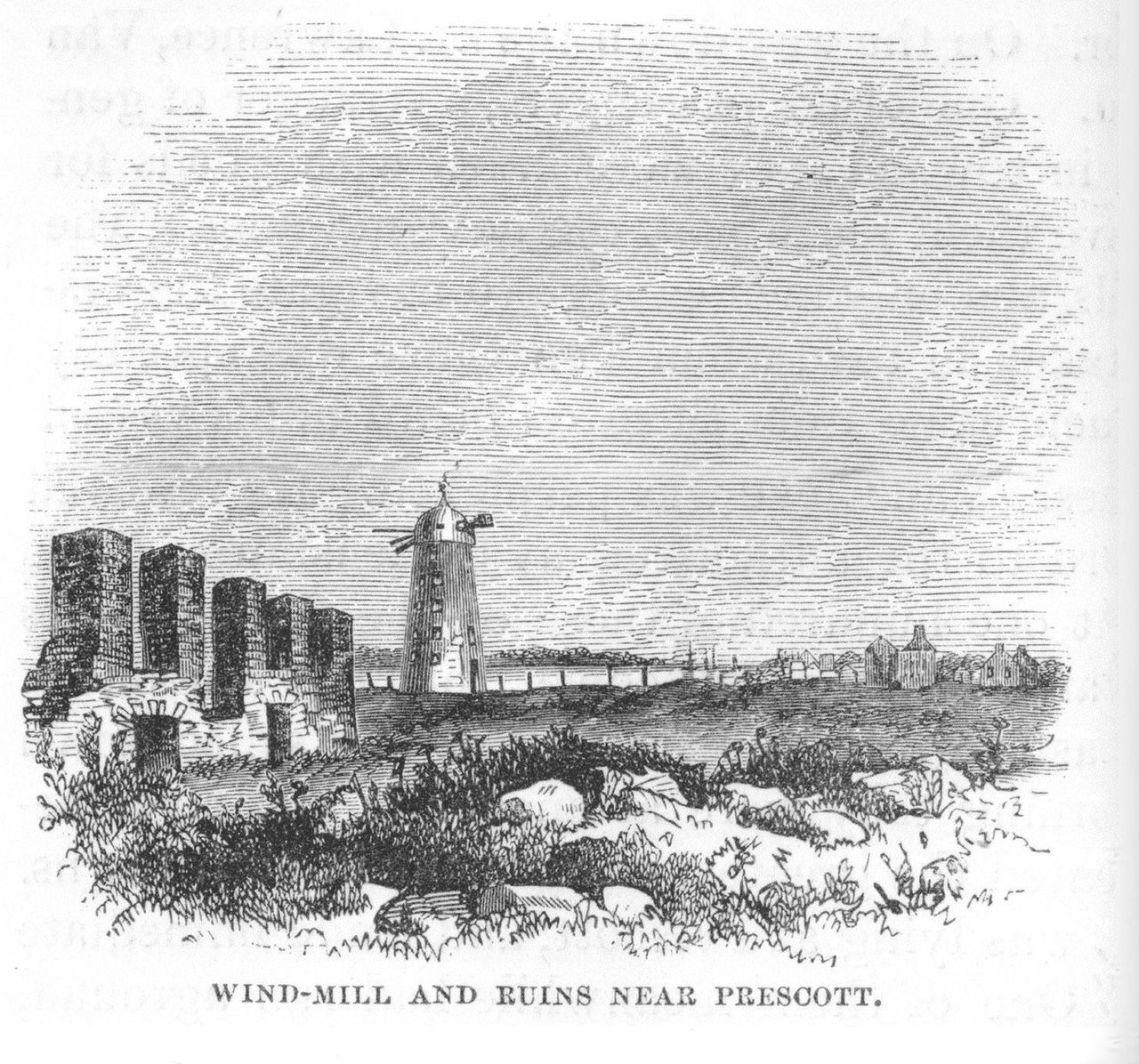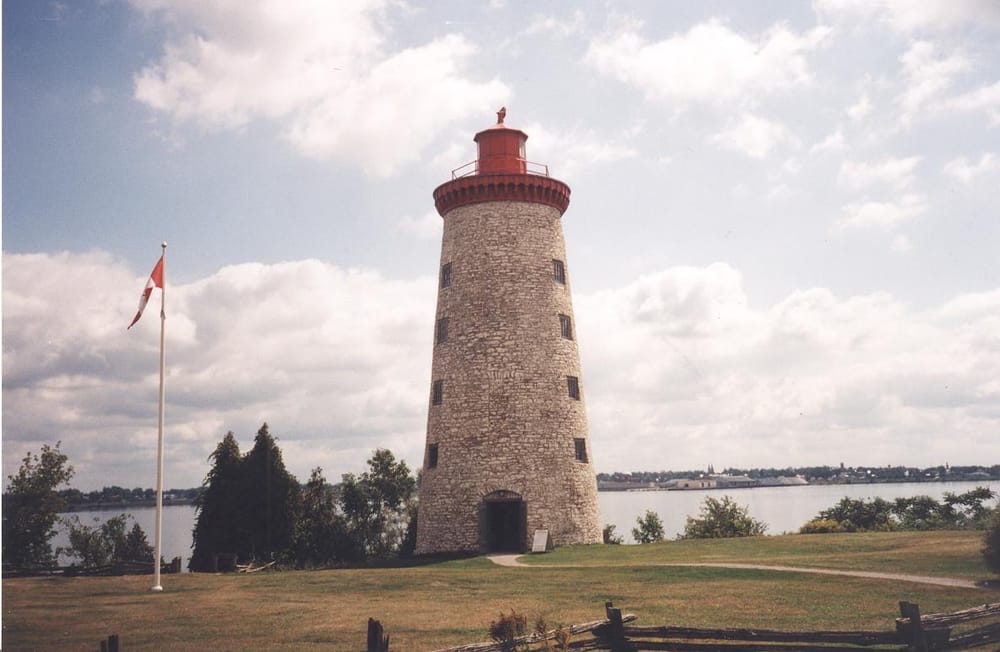Windmill Point Lighthouse
by: Mary Alice Snetsinger
Windmill Point Lighthouse overlooks the River just east of Prescott, ON. This was one of the last of the lighthouses established on the Canadian side of the Thousand Islands, yet it is the oldest of the built structures. It was the most easterly of the lighthouses, the first of the lighthouses to become an unwatched light, then to be discontinued. It also is one of only three that remain standing today, its a testament to its strength – weathered but enduring.
It was “The Battle of the Windmill” that ensured the long-term preservation of this site, as the stone tower was a focal point of the battle that took place here in 1838. The tower was almost new then, a windmill built only six years earlier by West India merchant Thomas Hughes.
This was a period of political unrest. Then a British colony, many in Upper and Lower Canada were pressing for reforms. An armed revolt a year earlier had been suppressed, and many of the rebels had fled to the United States.

In November 1838, approximately 190 members of a “Hunter’s Lodge,” a secret paramilitary group that included exiled rebels and sympathetic Americans, landed in Canada, ready to “free” Canadians from the yoke of British rule. The story of the ill-fated invasion has been told in other articles published in Thousand Islands Life magazine. Suffice it to say that the local population failed to rally to the cause, and that the invaders did not receive either rations or reinforcements from the other side of the River. After a unit of British regulars arrived to reinforce local militias, and began bombarding the windmill, the rebels, who had retreated to the relative safety of the windmill tower, surrendered unconditionally. The perpetrators were tried, and assorted hangings, deportations, and releases followed. The windmill was sorely battered during the battle, and afterward became a temporary military post.

Reinvention of the abandoned tower occurred in 1872, when the Canadian government determined that it was a suitable and strategic spot for a lighthouse. Applications had been made many times for a lighthouse at Windmill Point, a relatively narrow point in the River between Prescott, ON and Ogdensburg, NY. The former windmill tower, described as “a very strong and substantial building,” seemed ideal.
Extensive work was required to adapt and equip the tower for use as a lighthouse. The final cost, including the land purchase (at a price of $600) was $3,266.27. The tower stood 62 feet (about 18.9 metres) in height, but 92 feet (about 28 metres) above the water. Showing a fixed white light, consisting of four mammoth flat-wick lamps with 18-inch reflectors, it was visible at a distance of around 15 miles (about 24 km).
At 61 years old, Bernard Kean also reinvented himself when he became the first keeper of the lighthouse. Born in Ireland, he emigrated to Canada as a child. He operated a tavern and inn in Montreal in the 1840s and 50s, then moved to Cardinal, near Prescott, to do the same. Apparently ready for a change, Bernard Kean became the lightkeeper at Windmill Point in 1872, at an annual salary of $150.00. Interestingly, the 1869 annual report of the Department of Marine and Fisheries, stated that the average salary of the lightkeepers ranged from $200 to $560; it is supposed that this mainland site was considered to be an easier position. It is little wonder that lightkeepers typically had other, supplementary, means of income.

Bernard Kean acted as keeper for nine years, resigning June 30, 1881. His name does appear in subsequent statements of expenditure for the lighthouse; for example, in 1883 he was paid $2.25 for work on chimneys, and another $20.00 for firewood for over eight years. Whether he was providing additional services, or if this was a settling of past accounts is not clear. Bernard Kean died in 1887, and is buried in the Cimetière Notre-Dame-des-Neiges in Montreal.
The subsequent lightkeeper of Windmill Point was Samuel Robert Scarlot, about whom nothing is known but his name in the government records. He resigned a little over a year later, acting from July 1881 to November 1882. Ward Skinner Plumb became the third keeper in 1882, remaining until the Minister of Marine and Fisheries recommended in 1901 that “in the public interest the appointment of Mr. Plumb be cancelled.” It seems likely that Mr. Plumb was having health problems, for he died in 1905 at only 60 years of age. He is buried in Prescott with his first wife, Elizabeth, who had been born a Fraser; perhaps there was a family connection to John Fraser, who became the fourth and final keeper at the lighthouse.
When John Fraser was appointed in 1901, changes were already afoot. The government was finding the expense of lightkeepers and lighthouse maintenance to be a burden, and was looking for efficiencies. In August 1902, experiments were conducted on board Coast Guard ship Scout to investigate the suitability of acetylene for the lighthouses, with the stated intent that their operation would become “practically automatic.” In 1904, the lighthouses in the Thousand Islands would be switched to acetylene fuel, and several lightkeepers accordingly would be dismissed.
Another change came in the form of the Dominion Light Depot. The Department of Marine and Fisheries purchased the property in late 1903. It was then renovated to support its role as a depot, where specialized equipment for the lighthouse service were made, stored, and distributed from there. It also served as headquarters for the department’s steamers for the Montreal-Kingston division.

Therefore, John Fraser was dismissed as lightkeeper in 1904, when the lighthouses were all switched to acetylene, and Windmill Point became unwatched. While the department reversed that fuelling decision a few years later, Windmill Point did not get back its lightkeeper, as did the other Thousand Islands lighthouses. With the Dominion Light Depot only two miles to the west, staff there could easily check on this mainland lighthouse as needed.
The lighthouse at Windmill Point continued to operate as an unwatched lighthouse for several more years, going through modifications in 1920 and 1937, as technological advances occurred. Other technological advances were also happening, however, and the need for (expensive) lighthouses was waning. It was eventually decommissioned as a lighthouse in 1978, and today a light buoy just off Windmill Point replaces it.

Today, the lighthouse is protected by Parks Canada as the Battle of the Windmill National Historic Site. The lighthouse is readily accessible by road for a visit any day or time of the year, and interpretive signs offer information on the most interesting points about its history. The tower itself is open to the public periodically courtesy of the volunteers among the Friends of Windmill Point during July and August each year. Be sure to check online for hours of operation if you want to see inside the tower. While there are some purists who would like to see the structure renovated to showcase its appearance back in 1838, its multiple roles over the decades are recognized, and Parks Canada maintains it as it looked when discontinued as a lighthouse. Its navigational role now, however, is only as a daymark for mariners using the St. Lawrence River in the Prescott area.
By Mary Alice Snetsinger
Mary Alice Snetsinger grew up in the United States and Canada, and worked for four years at Thousand Islands National Park. She became interested in the 19th century lighthouses of the Thousand Islands in 1997 and has been researching them ever since. Mary Alice provided TI Life with articles about 15 Thousand Islands Lighthouses. Be sure to see our two sets of articles: before 2019 and after 2019. What a wealth of history and interest. Contact Mary Alice Snetsinger at ecoserv@kos.net.
Editor's Note: Once again we thank you Mary Alice... this may be the last one, but I am sure you are looking for more.







Please click here if you are unable to post your comment.